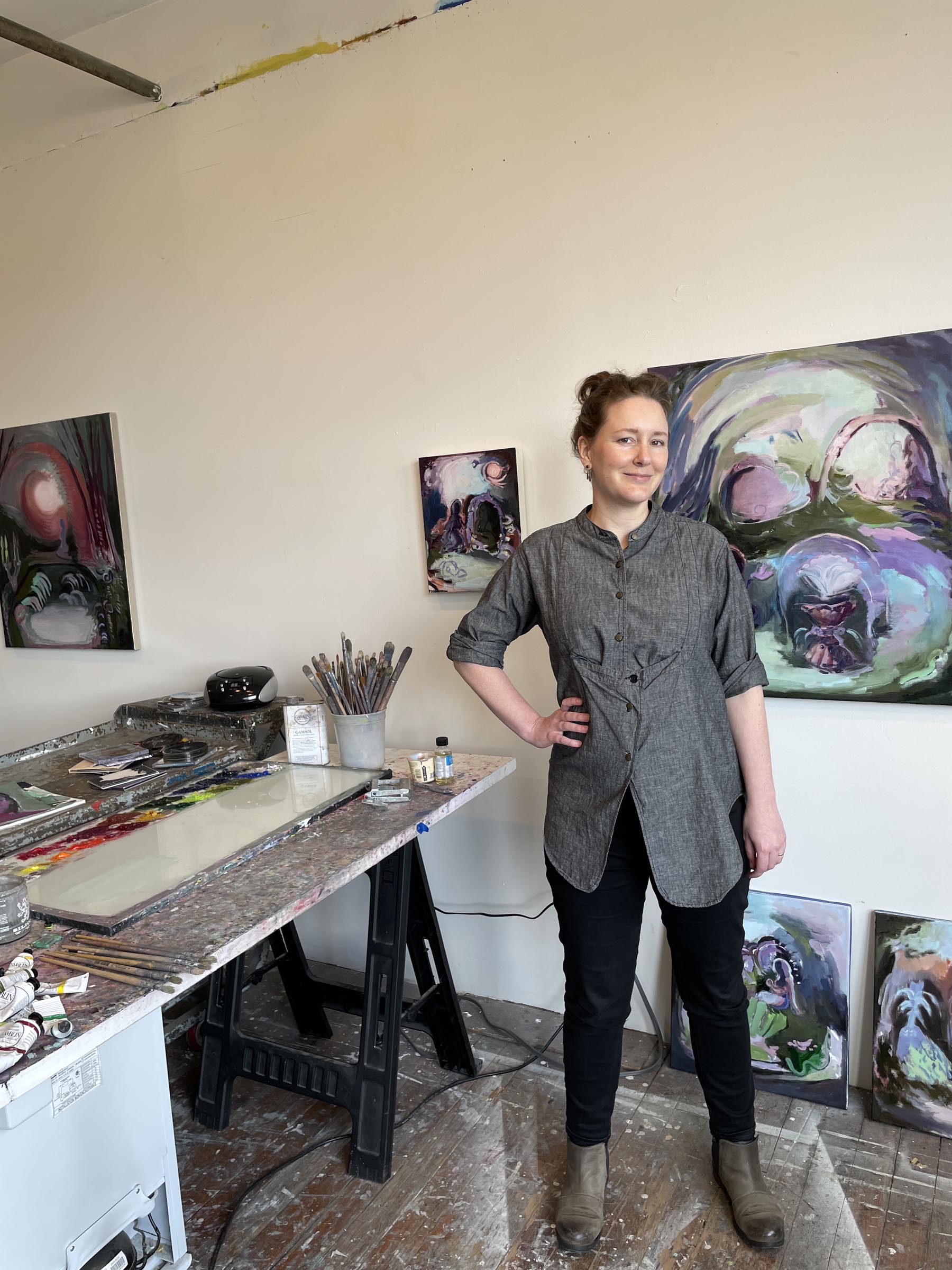How did you get into making art?
My mother is a painter and I began making art at a very young age. As a child I took a lot of classes in a wide variety of mediums like ceramics, glass, printmaking, sculpture, and drawing. Drawing was always by far my favorite and I remember being really intimidated and worried that the obvious next step (I thought) for a drawer was to start painting. The idea of having to mix every color and make each mark with such intentionality was honestly terrifying. But I ended up falling in love with painting in high school and college and now it’s really the only medium that calls to me.
What are you currently working on?
I’m working on small and medium sized oil paintings that feature female figures in lush abstracted landscapes. The work is driven by ideas of the visibility/ consumability of the female body, a desire for connection with the natural world, and the politics of rest and relaxation.
The work is driven by ideas of the visibility / consumability of the female body, a desire for connection with the natural world, and the politics of rest and relaxation.
Anya Roberts-Toney

What inspired you to get started on this body of work?
I didn’t really “start” this body of work so much as I cleared out my studio to hang a solo show and these are the paintings that came next. That said, I’m definitely witnessing a shift in the work wherein it’s becoming looser and has more moments of abstraction. I’ll always be a figurative/representational artist to some extent—I need that kind of specificity in my work—but I’m drawn to so many of the ideas that drive contemporary abstract painting, like quick shifts in style, interruption, layering, framing, and impasto. With each new body of work I’m trying to more fully incorporate these ideas while still being true to the themes in my work that excited me. I think that’s manifesting now as the figures being more a part of the landscape, and I’m becoming less interested in depicting specific actions or poses, and instead am using mark making and gesture to communicate energy. It’s a loose goal but really the exploration is what’s most exciting these days and I’m having fun getting messy and letting strange, unexpected moments emerge from the paint.

Do you work on distinct projects or do you take a broader approach to your practice?
I take a broad approach to my work and can play with the same themes and imagery for a long time. One thing that I do find pushes my work forward is writing about it for a press release or grant application. Often I find that there’s something in the work that I really want to talk about, but it’s such a small part of a body of work that it would be disingenuous to call it a central theme. So I’ll go back to the studio and really focus on that theme until it becomes central enough to be a key talking point. It doesn’t mean that the work changes drastically from one day to the next, but instead it helps me expand the conversation in a direction that feels honest and generative.

What’s a typical day like in your studio?
I usually get to my studio around 9:30 am and spend the first half hour just getting situated and drinking my coffee. It’s only once I’ve been in the studio for a while that I actually look at what I’ve been working on. I make thumbnail sketches of the in-progress painting or paintings, and make little notes about what needs fixing, what needs waking up. I’ll make a list of colors or themes that are active in the composition to try and think about the painting in a different way. And then eventually I get up and start mixing colors for the day. My goal in the studio is to get into a kind of meditative state where I turn off my thoughts and just let myself react intuitively to the painting. I’ll often listen to the same CD all day, and I choose music that has the same kind of energy I’m trying to create in my work: urgent, a little haunting, fiercely feminine, sensuous. For the last few years that’s meant a ton of PJ Harvey, and more recently Sharon Van Etten, Sleater-Kinney, and Weyes Blood. Once I’ve been painting for a few hours, I take intermittent breaks to look at what I’ve done, make more sketches, scribble notes, etc. While I don’t make preliminary drawings for my paintings, I’ll often make really quick thumbnail sketches for new paintings while I’m making notes on existing ones, and when I need a stopping point in one piece I’ll start something new. Often the new piece plays on something happening in the current piece but takes it in a new direction.



Who are your favorite artists?
The list is always expanding, but lately my faves are Katherina Olschbaur, Amy Bessone, Jennifer Packer, Ambera Wellman, Kaye Donachie, Noah Davis, Elizabeth Huey, Patricia Iglesias Peco, Danielle McKinney, Shanna Waddell, Faye Wei Wei, Cecily Brown, and of course Marlene Dumas. My old-school favorites include Redon, Bonnard, Manet, and Fantin-Latour.
Where do you go to discover new artists?
Before covid my partner and I made a point to get down to LA at least once a year to see art—there are so many amazing female painters making work in LA right now. These days I’m pretty reliant on Instagram to discover new artists, but I also do my best to get out to shows at Portland galleries, and my painter friends and I are always sharing recommendations.
Learn more about the artist by visiting the following links:







































































